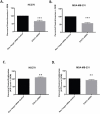Genomic regulation of invasion by STAT3 in triple negative breast cancer
- PMID: 28030809
- PMCID: PMC5352396
- DOI: 10.18632/oncotarget.14153
Genomic regulation of invasion by STAT3 in triple negative breast cancer
Abstract
Breast cancer is a heterogeneous disease comprised of four molecular subtypes defined by whether the tumor-originating cells are luminal or basal epithelial cells. Breast cancers arising from the luminal mammary duct often express estrogen receptor (ER), progesterone receptor (PR), and human epidermal growth receptor 2 (HER2). Tumors expressing ER and/or PR are treated with anti-hormonal therapies, while tumors overexpressing HER2 are targeted with monoclonal antibodies. Immunohistochemical detection of ER, PR, and HER2 receptors/proteins is a critical step in breast cancer diagnosis and guided treatment. Breast tumors that do not express these proteins are known as "triple negative breast cancer" (TNBC) and are typically basal-like. TNBCs are the most aggressive subtype, with the highest mortality rates and no targeted therapy, so there is a pressing need to identify important TNBC tumor regulators. The signal transducer and activator of transcription 3 (STAT3) transcription factor has been previously implicated as a constitutively active oncogene in TNBC. However, its direct regulatory gene targets and tumorigenic properties have not been well characterized. By integrating RNA-seq and ChIP-seq data from 2 TNBC tumors and 5 cell lines, we discovered novel gene signatures directly regulated by STAT3 that were enriched for processes involving inflammation, immunity, and invasion in TNBC. Functional analysis revealed that STAT3 has a key role regulating invasion and metastasis, a characteristic often associated with TNBC. Our findings suggest therapies targeting STAT3 may be important for preventing TNBC metastasis.
Keywords: ChIP-seq; RNA-seq; STAT3; TNBC; invasion.
Conflict of interest statement
The authors declare no conflicts of interest.
Figures



Comment in
-
TNBC invasion: downstream of STAT3.Oncotarget. 2017 Mar 28;8(13):20517-20518. doi: 10.18632/oncotarget.15259. Oncotarget. 2017. PMID: 28199968 Free PMC article. No abstract available.
Similar articles
-
Phosphorylated STAT3 (Tyr705) as a biomarker of response to pimozide treatment in triple-negative breast cancer.Cancer Biol Ther. 2020 Jun 2;21(6):506-521. doi: 10.1080/15384047.2020.1726718. Epub 2020 Mar 13. Cancer Biol Ther. 2020. PMID: 32164483 Free PMC article.
-
STAT3 Targets ERR-α to Promote Epithelial-Mesenchymal Transition, Migration, and Invasion in Triple-Negative Breast Cancer Cells.Mol Cancer Res. 2019 Nov;17(11):2184-2195. doi: 10.1158/1541-7786.MCR-18-1194. Epub 2019 Aug 19. Mol Cancer Res. 2019. PMID: 31427441
-
Interaction between STAT3 and GLI1/tGLI1 oncogenic transcription factors promotes the aggressiveness of triple-negative breast cancers and HER2-enriched breast cancer.Oncogene. 2018 May;37(19):2502-2514. doi: 10.1038/s41388-018-0132-4. Epub 2018 Feb 16. Oncogene. 2018. PMID: 29449694 Free PMC article.
-
STAT3 as a potential therapeutic target in triple negative breast cancer: a systematic review.J Exp Clin Cancer Res. 2019 May 14;38(1):195. doi: 10.1186/s13046-019-1206-z. J Exp Clin Cancer Res. 2019. PMID: 31088482 Free PMC article.
-
Stress-induced EGF receptor signaling through STAT3 and tumor progression in triple-negative breast cancer.Mol Cell Endocrinol. 2017 Aug 15;451:24-30. doi: 10.1016/j.mce.2017.01.013. Epub 2017 Jan 12. Mol Cell Endocrinol. 2017. PMID: 28088463 Free PMC article. Review.
Cited by
-
Nuclear Expression of p-STAT3 Is Associated with Poor Prognosis in ER(-) Breast Cancer.Clin Pract. 2022 Feb 25;12(2):157-167. doi: 10.3390/clinpract12020020. Clin Pract. 2022. PMID: 35314590 Free PMC article.
-
Chemoresistance in the Human Triple-Negative Breast Cancer Cell Line MDA-MB-231 Induced by Doxorubicin Gradient Is Associated with Epigenetic Alterations in Histone Deacetylase.J Oncol. 2019 Jun 2;2019:1345026. doi: 10.1155/2019/1345026. eCollection 2019. J Oncol. 2019. PMID: 31275376 Free PMC article.
-
MicroRNA‑124 suppresses cell proliferation and invasion of triple negative breast cancer cells by targeting STAT3.Mol Med Rep. 2019 May;19(5):3667-3675. doi: 10.3892/mmr.2019.10044. Epub 2019 Mar 15. Mol Med Rep. 2019. PMID: 30896795 Free PMC article.
-
TNBC invasion: downstream of STAT3.Oncotarget. 2017 Mar 28;8(13):20517-20518. doi: 10.18632/oncotarget.15259. Oncotarget. 2017. PMID: 28199968 Free PMC article. No abstract available.
-
Targeting the HLA-E-NKG2A axis in combination with MS-275 enhances NK cell-based immunotherapy against DMG.J Exp Clin Cancer Res. 2025 Apr 29;44(1):133. doi: 10.1186/s13046-025-03390-y. J Exp Clin Cancer Res. 2025. PMID: 40296045 Free PMC article.
References
-
- Sorlie T, Perou CM, Tibshirani R, Aas T, Geisler S, Johnsen H, Hastie T, Eisen MB, van de Rijn M, Jeffrey SS, Thorsen T, Quist H, Matese JC, et al. Gene expression patterns of breast carcinomas distinguish tumor subclasses with clinical implications. Proc Natl Acad Sci U S A. 2001;98:10869–74. doi: 10.1073/pnas.191367098. - DOI - PMC - PubMed
MeSH terms
Substances
Grants and funding
LinkOut - more resources
Full Text Sources
Other Literature Sources
Molecular Biology Databases
Research Materials
Miscellaneous

